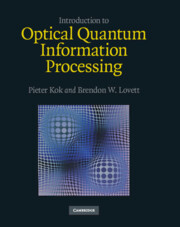Book contents
- Frontmatter
- Dedication
- Contents
- Preface
- Part I Quantum optics and quantum information
- Part II Quantum information in photons and atoms
- Part III Quantum information in many-body systems
- 8 Quantum communication with continuous variables
- 9 Quantum computation with continuous variables
- 10 Atomic ensembles in quantum information processing
- 11 Solid-state quantum information carriers
- 12 Decoherence of solid-state qubits
- 13 Quantum metrology
- Appendix A Baker–Campbell–Haussdorff relations
- Appendix B The Knill–Laflamme–Milburn protocol
- Appendix C Cross–Kerr nonlinearities for single photons
- References
- Index
10 - Atomic ensembles in quantum information processing
from Part III - Quantum information in many-body systems
Published online by Cambridge University Press: 05 July 2014
- Frontmatter
- Dedication
- Contents
- Preface
- Part I Quantum optics and quantum information
- Part II Quantum information in photons and atoms
- Part III Quantum information in many-body systems
- 8 Quantum communication with continuous variables
- 9 Quantum computation with continuous variables
- 10 Atomic ensembles in quantum information processing
- 11 Solid-state quantum information carriers
- 12 Decoherence of solid-state qubits
- 13 Quantum metrology
- Appendix A Baker–Campbell–Haussdorff relations
- Appendix B The Knill–Laflamme–Milburn protocol
- Appendix C Cross–Kerr nonlinearities for single photons
- References
- Index
Summary
In Chapter 7 we discussed the interaction between atoms and photons. We found that the coupling between a single atom and a single photon is rather weak, unless the atom and the photon are contained within a small cavity. The only way to significantly affect a free atom with light is to use a state of light with many photons, and in particular we showed how to use classical laser fields to prepare particular atomic states. However, there is another way of enhancing the interaction in a useful way. We can use many atoms rather than a single one. In this chapter, we will show that the interaction between a single photon and an ensemble of atoms can be greatly increased through the phenomenon of collective enhancement. We will show that this gives an atomic ensemble a relatively large susceptibility, and that multilevel atoms can be used to generate large optical nonlinearities. These offer the possibility of slowing, and even stopping, a beam of light; a phenomenon that goes hand in hand with electromagnetically induced transparency. We will discuss how a quantum state of light can be stored in and retrieved from an ensemble of atoms, and how the states of different atomic ensembles can be entangled with one another. We will show that collective states of atoms can even be used as a single qubit or several qubits, and finally, we will show that atomic ensembles can be use to mediate a photon–photon interaction.
- Type
- Chapter
- Information
- Introduction to Optical Quantum Information Processing , pp. 327 - 360Publisher: Cambridge University PressPrint publication year: 2010



